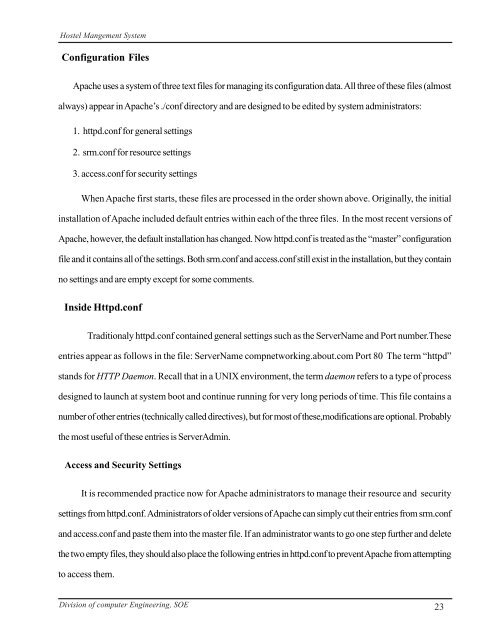hostel management system - DSpace at CUSAT - Cochin University ...
hostel management system - DSpace at CUSAT - Cochin University ...
hostel management system - DSpace at CUSAT - Cochin University ...
You also want an ePaper? Increase the reach of your titles
YUMPU automatically turns print PDFs into web optimized ePapers that Google loves.
Hostel Mangement System<br />
Configur<strong>at</strong>ion Files<br />
Apache uses a <strong>system</strong> of three text files for managing its configur<strong>at</strong>ion d<strong>at</strong>a. All three of these files (almost<br />
always) appear in Apache’s ./conf directory and are designed to be edited by <strong>system</strong> administr<strong>at</strong>ors:<br />
1. httpd.conf for general settings<br />
2. srm.conf for resource settings<br />
3. access.conf for security settings<br />
When Apache first starts, these files are processed in the order shown above. Originally, the initial<br />
install<strong>at</strong>ion of Apache included default entries within each of the three files. In the most recent versions of<br />
Apache, however, the default install<strong>at</strong>ion has changed. Now httpd.conf is tre<strong>at</strong>ed as the “master” configur<strong>at</strong>ion<br />
file and it contains all of the settings. Both srm.conf and access.conf still exist in the install<strong>at</strong>ion, but they contain<br />
no settings and are empty except for some comments.<br />
Inside Httpd.conf<br />
Traditionaly httpd.conf contained general settings such as the ServerName and Port number.These<br />
entries appear as follows in the file: ServerName compnetworking.about.com Port 80 The term “httpd”<br />
stands for HTTP Daemon. Recall th<strong>at</strong> in a UNIX environment, the term daemon refers to a type of process<br />
designed to launch <strong>at</strong> <strong>system</strong> boot and continue running for very long periods of time. This file contains a<br />
number of other entries (technically called directives), but for most of these,modific<strong>at</strong>ions are optional. Probably<br />
the most useful of these entries is ServerAdmin.<br />
Access and Security Settings<br />
It is recommended practice now for Apache administr<strong>at</strong>ors to manage their resource and security<br />
settings from httpd.conf. Administr<strong>at</strong>ors of older versions of Apache can simply cut their entries from srm.conf<br />
and access.conf and paste them into the master file. If an administr<strong>at</strong>or wants to go one step further and delete<br />
the two empty files, they should also place the following entries in httpd.conf to prevent Apache from <strong>at</strong>tempting<br />
to access them.<br />
Division of computer Engineering, SOE 23
















